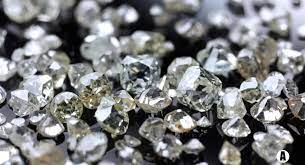Zimbabwe, the world’s seventh-largest diamond producer, earned $424 million in diamond earnings in 2022, according to the Zimbabwe Consolidated Diamond Company (ZCDC).
The company said the output is “not bad” in comparison to established mining countries since mining operations in Chiadzwa were regularized in 2016.
According to ZCDC, the country’s diamond sector is still in its infancy, with officials comparing its formal six to seven years of operation to that of a “Grade One child who is still starting out but has more to offer in the coming years,” amid concerns that revenues in Zimbabwe are not meeting expectations as people believe proceeds are misappropriated rather than helping to improve social sectors.
ZCDC is 100 percent owned by the Zimbabwean government but registered as a private company under the Companies Act Chapter 24:03 and holds exploration and mining titles for other areas across the country.
ZCDC Mine Manager Admore Mangoma, who was representing ZCDC Chief Executive Officer Dennis Mtombeni at a media workshop on responsible diamond mining reporting conducted in Mutare on Tuesday, told journalists that only four companies are permitted to mine and explore for diamonds in Zimbabwe.
“ZCDC is at the forefront, then Murowa – a private company owned by Rio-Zim, Anjin (a Chinese mining firm) and (Russian-owned) Alrosa, which is the largest diamond producer by volume (the largest producer of diamonds by value is Botswana),” he said.
According to ZCDC Finance and Business Analyst, Albert Norumedzo, Zimbabwe’s revenue for 2022 was $424 million.
“The biggest diamond producers are Botswana which started mining in 1967 and their last revenue for 2022 was US$4.7 billion. Second is Russia, with mining giant Alrosa making US$3.5 billion, Angola – US$1.9 billion, and South Africa -whose diamond mining by DeBeers started in the 1800s was US$1.5 billion for 2022. Namibia, which mines in the sea in partnership with Botswana made US$1.2 billion then Zimbabwe had US$424 million as revenue for 2022,” he said.
“After Zimbabwe, there are other countries such as Lesotho, Australia, Sierra Leone, Tanzania, DRC and others.”
Norumedzo said in the global value of rough diamonds, Zimbabwe represents 2.61 percent and is number seven of the world’s largest diamond producers.
“In terms of the value chain globally, when we mine rough diamonds, the output ends up in jewellery, and the size of that jewellery market is US$80 billion,” said the business analyst, adding that the global long-term expectation for the diamond business, as forecasted by experts, was rising.
“Experts predict that as we approach 2050, the number of new mines will decline, and there will be no new discoveries, natural diamond supply will fall, but demand will rise. It gives us a picture that demand prospects are good for the industry in the long term even though we have less natural diamonds.”
“That’s why Zimbabwe, ZCDC has a joint venture of exploration for new mines with Alrosa trying to find new discoveries. Diamonds derive their perception from rarity -it shows prospects for the future of the industry are quite good despite short term trends.”
In an effort to find fresh diamond resources, the ZCDC Mine Manager concurred the company has created a joint venture with Alrosa, to explore and mine for kimberlite deposits in Mwenezi and Chimanimani.
“Alrosa is ahead in terms of technical expertise, knowledge, and mining history, and ZCDC has partnered with them for exploration,” he said.
“Alrosa is leading exploration and is doing exploration in Mwenezi and Chimanimani. This exploration is called a greenfield exploration, like the ground roots where you are looking for kimberlites, which are referred to as primary diamond sources.”
He also stated that ZCDC’s diamond fields in Chiadzwa are “very expansive, with a quantum of more than 32 million of diamond resources,” meaning its mining operations were still active.
“ZCDC has its quota while Anjin has the other ground at Chiadzwa. In terms of the economic life of the mine, ZCDC has 12 years, then in terms of economic life of the source, ZCDC has more than 40 years,” he said.
Meanwhile, the ZCDC business analyst said there were recent market developments that affected current and past performance of diamond sales.
“50 percent of the diamonds that are produced, which is US$40 billion ends up in the United States. If 50 percent of your market base is in a certain geographical area, whatever happens in that market base, whether short term or long term affects your prospects for that year,” he said, noting there was a softening of diamond consumption in America due to a number of issues.
ZCDC Head of Public Relations, Sugar Chagonda, said to fulfil the Chiadzwa and Chimanimani community expectations, the company implements social responsibility projects to spur community development.
“These initiatives fit well with our three horizons of framework, Diamonds of Today, Diamonds of Tomorrow and Life Beyond Diamond Mining,” he said, adding that ZCDC had injected about US$60 000 a month under the community buying framework where the company sources everything from locals in Manicaland.
“At six years, we are just like a Grade One learner so what can you expect from a Grade One?”

